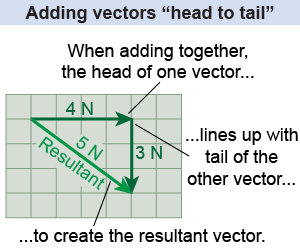|
Most real situations involve two or more forces acting at the same time. When multiple forces act on an object, the resulting motion depends on the net force, which is the sum of the forces. As an example, consider a block at rest on a flat table. The block is pulled by a 3 N force and a 4 N force that are perpendicular to each other. 
|
In what direction will the box move? Intuitively, you know the box moves at an angle in between the two forces. How do you add forces that are in different directions? Simple addition gives 4 N + 3 N = 7 N, but that is the wrong answer because the forces do not act in the same direction. Forces can only be added in this way if they have the same line of action, meaning that they are either in the same direction or in exactly opposite directions. The forces in this example are at right angles to each other, so they do not have the same line of action. 
|

|
This is a two-dimensional problem and must be solved by thinking in two dimensions. A resultant vector is a single vector that represents the net sum of two or more individual vectors. Here, two force vectors add to create a resultant force vector. 
|
 To find the resultant of the two forces in the example, the 4 N force is drawn to scale on a vector diagram, starting from the origin. To add the second force, the 3 N vector is drawn from the end of the 4 N vector rather than from the origin. The 3 N force vector ends at coordinates of (4,–3) N on the scale diagram. The resultant force is the bold green vector drawn from the tail of the first vector, at the origin, to the head of the second vector at (4,−3) N on the diagram. Measuring the length of the arrow yields a value of 5 cm = 5 N, so the resultant of these two forces is a single force of 5 N at an angle of −36.9°. The block accelerates in the direction of the 5 N resultant force.
To find the resultant of the two forces in the example, the 4 N force is drawn to scale on a vector diagram, starting from the origin. To add the second force, the 3 N vector is drawn from the end of the 4 N vector rather than from the origin. The 3 N force vector ends at coordinates of (4,–3) N on the scale diagram. The resultant force is the bold green vector drawn from the tail of the first vector, at the origin, to the head of the second vector at (4,−3) N on the diagram. Measuring the length of the arrow yields a value of 5 cm = 5 N, so the resultant of these two forces is a single force of 5 N at an angle of −36.9°. The block accelerates in the direction of the 5 N resultant force. 
 |
A vector diagram is a very instructive way to add vectors because you can see how the direction of each vector contributes to the resultant. Note that it does not matter in which order you draw the vectors. Starting with the 3 N force instead of the 4 N force produces the same result. The resultant force, not the individual forces, determines the motion of the box. The direction of the resultant is also the direction of motion: The box will accelerate along a line 36.9° from the 4 N force. 
|
Subtracting a force is the same as adding the force in the opposite direction. To find the negative of a force, draw the same length as the original force along the same line of action, but pointing away from the origin in the opposite direction. For example, the opposite force from (4,–3) N is (–4,3) N. Notice that each of the x and y values changed sign. Both forces have a magnitude of 5 N, but they are in opposite directions. 
|
| |
|

